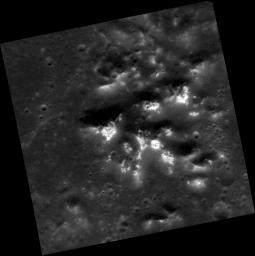
|
Every Day is Hollow-een
- Click the image above for a larger view
- Full-Res JPEG (1207 x 1210) (119.5 kB)
- Full-Res TIFF (1207 x 1210) (1.5 MB)
Caption:
Today's image features the central peak complex of a large, unnamed crater on the plains surrounding the Caloris basin, roughly 400 km (250 mi) northwest of the crater Munch . The image has been stretched to highlight the details of the hollows that are forming on the crests of the peaks. The bright hollows on Mercury stand out in stark contrast to the low reflectance material with which they are frequently associated.
This image was acquired as a high-resolution targeted observation. Targeted observations are images of a small area on Mercury's surface at resolutions much higher than the 200-meter/pixel morphology base map. It is not possible to cover all of Mercury's surface at this high resolution, but typically several areas of high scientific interest are imaged in this mode each week.
Date acquired:
July 05, 2011
Image Mission Elapsed Time (MET):
218374017
Image ID:
466629
Instrument:
Narrow Angle Camera (NAC) of the Mercury Dual Imaging System (MDIS)
Center Latitude:
47.45°
Center Longitude:
145.6° E
Resolution:
30 meters/pixel
Scale:
The image is about 31 km (19 mi.) wide
Incidence Angle:
48.0°
Emission Angle:
5.6°
Phase Angle:
53.7°
Background Info:
The MESSENGER spacecraft is the first ever to orbit the planet Mercury, and the spacecraft's seven scientific instruments and radio science investigation are unraveling the history and evolution of the Solar System's innermost planet. MESSENGER acquired over 150,000 images and extensive other data sets. MESSENGER is capable of continuing orbital operations until early 2015.
For information regarding the use of images, see the MESSENGER image use policy .
Cataloging Keywords:
| Name | Value | Additional Values |
|---|---|---|
| Target | Mercury | |
| System | ||
| Target Type | Planet | |
| Mission | MESSENGER | |
| Instrument Host | MESSENGER | |
| Host Type | Orbiter | |
| Instrument | Mercury Dual Imaging System (MDIS) | |
| Detector | Narrow Angle Camera (NAC) | |
| Extra Keywords | Crater, Grayscale, Map, Radio | |
| Acquisition Date | ||
| Release Date | 2014-02-05 | |
| Date in Caption | 2011-07-05 | |
| Image Credit | NASA/Johns Hopkins University Applied Physics Laboratory/Carnegie Institution of Washington | |
| Source | photojournal.jpl.nasa.gov/catalog/PIA17974 | |
| Identifier | PIA17974 | |
